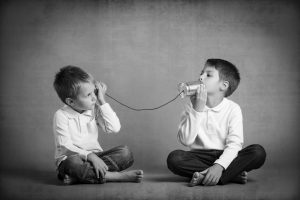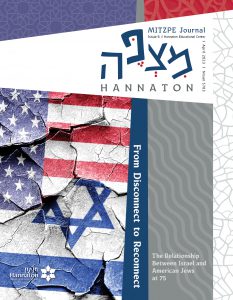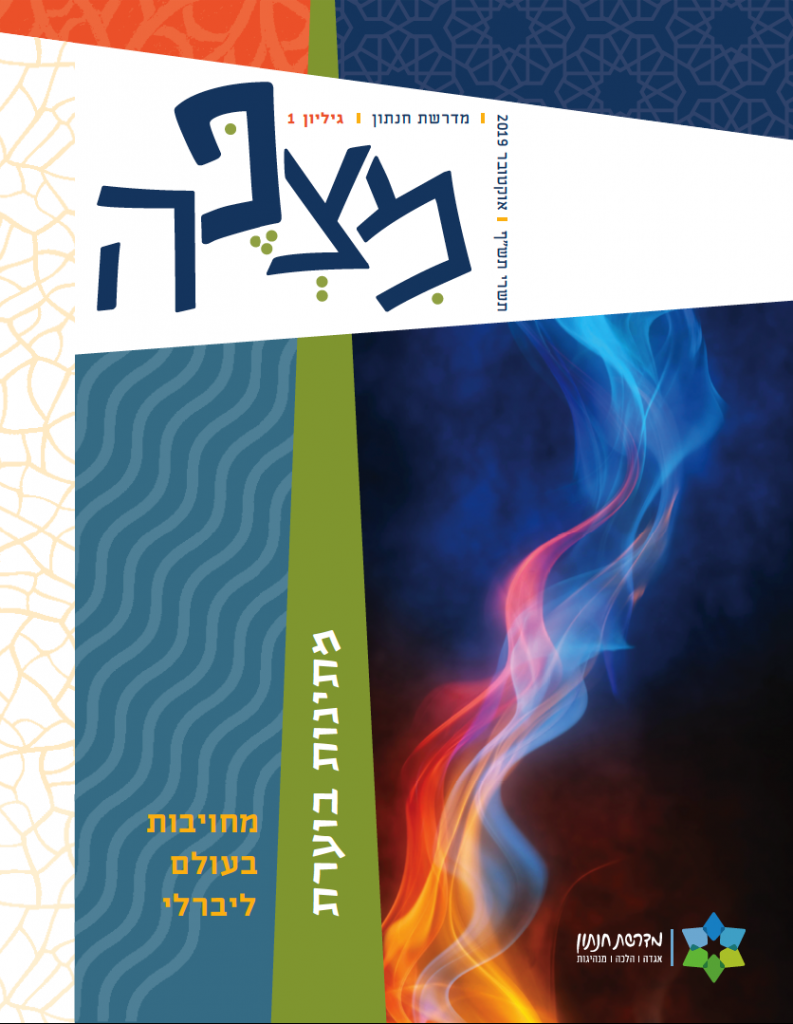Chaim Nahman Bialik, who is recognized as the State of Israel’s national poet, wrote the essay “Halakhah and Aggadah” in 1917, in which he moves between aggadah, which is really “story,” and halakhah, which is really “action.” Through that essay Bialik wants to ask: What is the place of story and what is the place of action? What says more about you? What does more to shape reality? And what is more important than what? Bialik concludes his essay with the call, “Let us have duties [mitzvot] imposed on us!”[1]
Bialik means to say that there is no point to a story that has no associated action, and maybe even that this kind of story is one in which there is no existential truth at all. After all, a story that has no connection to the reality in which we live is a “fiction,” an “invention,” a story that at best attests to our imagination or our imagined wishes but does not attest to who we are.
Let’s go back to the beginning of Bialik’s essay in order to clarify a bit more the matter of story versus action, halakhah compared to aggadah:
Halakhah wears a frown, Aggadah a smile. The one is pedantic, severe, unbending—all justice; the other is accommodating, lenient, pliable—all mercy. The one commands and knows no half-way house; hey yea is yea and her nay is nay. The other advises, and takes account of human limitations; she admits something between yea and nay.[2]
A story is flexible. It is like water: it has the power to break rocks, but it can just as well change its face and fool us. In contrast, action may seem inflexible: either you have done it or you have not, and there is only one answer. A story can both be and not be in the same breath.
The one is concerned with the shell, with the body, with actions; the other with the kernel, with the soul, with intentions. On one side there is petrified observance, duty, subjection; on the other perpetual rejuvenation, liberty, free volition.
Here Bialik moves from the descriptive to the judgmental. The living kernel is to be found in story, while the shell shell—the outer cloak that conceals, that is artificial—is to be found in action.
To these antitheses between halakhah and aggadah one might add endlessly. […] But must we conclude—as many think—that halakhah and aggadah are two irreconcilable opposites?
After positing a stark division between the two and toying with us, Bialik gets to the root of the matter:
Those who so conclude are confusing accident and form with substance: as who should declare the ice and the water in a river to be two different kinds of matter. Halakhah and aggadah are two things which are really one, two sides of a single shield. The relation between them is like that of speech to thought and emotion, or of action and sensible form to speech. Halakhah is the crystallization, the ultimate and inevitable quintessence of aggadah.
And so, story and action are one. Not only is it not so that one is truth and the other a lie or that one is simple and the other difficult, but in fact they are one thing, indivisible. One leads to the other, which leads to the first, which leads to the second, and so it goes, on and on.
If a story is a true story, an existential story that directs our lives and guides them by the belief within it; if a story is not mere fiction—whether intentionally or unintentionally—it must lead to action. And if that action is true, it becomes my own story, since from the action emerges the story that will foster the next action, and so on.
We came to this country from within a story (or within several stories), and that story created an action—a huge deed that actually became our story, which created more action, which became a story, which created action, and so it continues. That is to say, if a story does not engender action, or action does not produce a new story, then they contain no truth. Let me employ a few examples to explain my point. First, we will examine an act with no “truth” in it and then a story with no “truth” in it. In a totalitarian regime, everyone behaves as citizens who admire their leader. They show up for demonstrations of support for him, speak his praises, hate his enemies, and even wreak havoc upon his opponents. But at the first opportunity, they will murder their leader and the whole nation will break out in shouts of joy and excitement. There was no truth in their prior actions. They were acts of fakery, as is evident from the fact that the story that they engendered was not the leader’s continuing rule and the strengthening of the regime. Another example, from the realm of the individual: If an individual lives his or her life as a religious person, with all the outer trappings—Shabbat observance, daily prayer—but in his heart of hearts he is not a believer, not in the God to whom he prays and not in the life he lives, that person will sooner or later change the patterns of his life, or will be living one giant bluff, a sham that those close to him will easily recognize. As for the story without any truth, we need only look to the impassioned calls for unity that we hear frequently from public figures—while in fact they employ divisive tactics and even promote antipathy between segments of Israeli society. The story of hope for national unity is no more than a masquerade, since the action borne of it is quite the opposite. In our own individual worlds as well, a person can say, “tomorrow I’ll begin to diet,” but that tomorrow may never come.
There has to be congruence between the story that has existential truth and the action that it engenders. So far this is clear enough, but what happens if doesn’t actually work out that way? What happens when the story doesn’t provide the stimulus for an action, or when there is action that appears on the surface to flow from the story, but that action does not create any story that stems from it? Worse, what happens when there is a story that I tell myself, but it is not connected to my actions in life? For example, a person wakes up one morning and asks himself, “Why have I been working at what I do for thirty years already? I don’t enjoy it at all!” Or a woman wakes up one morning and asks herself, “Why am I married to this man? I don’t love him at all.” What happens when there is no congruence, or there is even direct opposition, between my aggadah and my halakhah? In such a situation, the gap leads to a crisis. So it is in our personal lives, and so it is in our life as a nation, as a state, as a society.
Does our story need to change? Does the Zionist story still direct our actions, or must it be updated?
Let’s look at our society from a bird’s eye view and ask: What is the story that we tell ourselves about ourselves, and what are the deeds that we do, and is there congruence between them? For example, as a society, we Israelis must reexamine the aggadah of our striving for peace and bring our actions in line with it. Does our story need to change? Does the Zionist story still direct our lives, or does it need to be updated? Perhaps our actions testify that our story is a bit outdated? Or do we still have a story that is both ancient and new, that motivates us to move forward all the time and challenges us?
The truth is that we Israelis have, as a society, more than a few stories and more than a few viewpoints, and perhaps the more appropriate question is whether we can all tell ourselves a common story of which we all are a part, a story that tell us who we are and also produces a picture of a shared future.
A myth is such a story, a powerful tale that relates our past and creates an ideal for our behavior in the future. Myth creates ethos.
A myth is a foundational story whose purpose is to more to shape our future than to tell about our past, and that is the source of its power. That is also the source of the fear it engenders and its great power of attraction. Who does not long for a lighthouse that tells a story in whose light one should undoubtedly stride forward, without hesitation? There is, after all, no half-myth or “limping” myth, because if a myth does not shine, no one walks in its light. Even so, there are myths that we try to destroy and erase from our consciousness. There are myths that we would like to revive, and there are some whose truthfulness we call into question. Did Trumpeldor really say “It is good to die for our country?” By asking this, we are really questioning whether this is a myth by whose light we truly want to live. I wonder about our desire to insist on making stories that actually occurred into invented fictions. Deliberating about myth is not supposed to mean concentrating on the past, but rather on the future we desire here.
Foundational stories of the past can come into conflict with values we hold today. Thus myth does not lead to ethos but instead crashes into it and wounds it. To bridge this gap without giving up on myth, we muster to our assistance creative exegetical tools. Sometimes interpretations of foundational stories that have become myths by which we live can turn those stories around 180 degrees.
The Akeda, the “binding of Isaac” in Genesis 22, is undoubtedly one of the foundational stories of our people and our Judaism. According to the midrashic legend in Yalkut Shim‘oni:
“And he [Abraham] placed him [Isaac] on the altar.”—Abraham’s eyes looked at Isaac, and Isaac’s eyes looked at the heavens. Tears welled up and fell from Abraham’s eyes until the pool of tears was as tall as him. He said, to him, “My son, since you have already expressed your readiness to relinquish your blood, your Creator will find a different sacrifice in your place.” At that moment his mouth opened with a great weeping and he sighed a great sigh, and his eyes wandered, seeking out the Shekhina [the Lord’s presence]. He lifted his voice and said, “I lift my eyes to the mountains; from where shall my help come? My help is from the Lord, maker of the heavens and the earth” (Ps. 121:1–2).
(Yalkut Shimoni Vayyera 1:101)
The midrash tells about Abraham crying without interruption, unprepared to place the knife on Isaac, until the Holy One noticed and finally heeded him and substituted a ram for Isaac. But according to the simple contextual meaning of the story, and in the more widely accepted interpretations as well, Abraham’s dedication to fulfilling the Lord’s command—even if it meant sacrificing his only son, whom he loved—is the ideal model for the believer. So what shall we choose? By which interpretation shall we live and educate our children? This gap between the mythological story as it is and our values today, which is the gap between myth and ethos, is what creates the desire to explode the myth, or, alternatively, to lend it an interpretation that changes the story so that it conforms to what we think is the right thing to do, enabling us to continue to hold by our contemporary ethics.
We are in the seventy-second year of the State of Israel. When the situation here was terribly grave, our story was clear: We are a people who seek independence, a people who desire to live. We created a state and we live well here by most standards, but what is our story? And what do our actions say about us? Zionism created myths, but Zionism changes and the stories change, and sometimes that creates confusion or a genuine clash. Since the story, our aggadah, must give birth to action, the absence of a shared Israeli story impedes any agreement about how we should be acting.
President Rivlin addressed us in his now-famous speech about the “tribes” of Israel, essentially calling on us to take note of the fact that our story has changed and we are in need of another shared story, perhaps even a new ethos, one that all the tribes can come together to agree about. Perhaps even if we do not agree on a picture of a bright future that we can all grasp onto, we can begin with agreeing about our foundational myths.
[1] Hayim Nahman Bialik, “Halachah and Aggadah,” transl. Leon Simon, in An Anthology of Hebrew Essays, vol. 2, ed. Israel Cohen and B.Y. Michali (Tel Aviv: Institute for the Translation of Hebrew Literature and Massada–P.E.C. Press, 1966), 388.
[2] This quotation and the subsequent ones are from Bialik, “Halachah and Aggadah,” 368.





